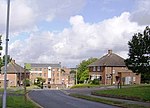St Georges Park (Newport)
St Georges Park was an association football stadium in Newport on the Isle of Wight. It was home to Newport (IOW) F.C. and the Isle of Wight official football team, which represents Isle of Wight at the bi-annual island games. The record attendance at the stadium is 3,112 in a pre-season friendly match against Portsmouth F.C. in 2008. Newport IW FC left St Georges Park in 2018 Currently they have been ground sharing with other Isle of Wight teams; however, the club were due to be relocating to a new purpose built sports stadium 'Wightfibre Park' in August 2022. However, this never materialised. Plans for the new stadium consisted of a new club house and seated stand, capacity of 150, as well as three sheltered standing stands with a total capacity of 500 to 1000 people.
Excerpt from the Wikipedia article St Georges Park (Newport) (License: CC BY-SA 3.0, Authors).St Georges Park (Newport)
Godric Road,
Geographical coordinates (GPS) Address External links Nearby Places Show on map
Geographical coordinates (GPS)
| Latitude | Longitude |
|---|---|
| N 50.694227777778 ° | E -1.2863833333333 ° |
Address
Saint George's Park (Newport FC)
Godric Road
PO30 2QH , Shide
England, United Kingdom
Open on Google Maps











